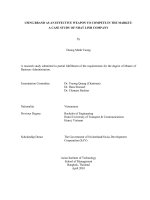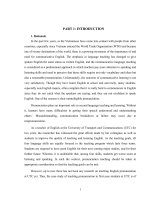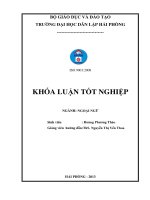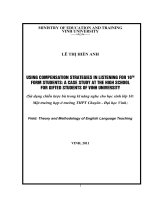Enhancement of coastal protection under the context of climate change A case study of
Bạn đang xem bản rút gọn của tài liệu. Xem và tải ngay bản đầy đủ của tài liệu tại đây (1.14 MB, 8 trang )
10th Asian Regional Conference of IAEG (2015)
Enhancement of coastal protection under the context of climate change: A case study of
Hai Hau coast, Vietnam
Do MINH DUC(1), Kazuya YASUHARA(2) and Nguyen MANH HIEU(1)
(1) Department of Geotechnics, Faculty of Geology, VNU University of Science,
Vietnam National University, Hanoi
E-mail:
(2) Institute for Global Change Adaptation Science, Ibaraki University, Japan
Abstract
Climate change and global warming have led to severe typhoons and sea level rise
(SLR) which may threat the stability of coastal structures. However, countermeasures to
enhance coastal protection against SLR and severe typhoons have not appropriately
considered in Vietnam. This paper focused on the enhancement of coastal protection in
Hai Hau district – the most serious erosion coast in the North Vietnam. Erosion in Hai
Hau coast has occurred continuously since the beginning of 20th century with average
retreat rates of 10-15 m/y. The maximum rates reached to 40-50 m/y in some segments.
Sea level is considered to rise about 2 mm/y on average in Vietnam. The number and
intensity of tropical cyclones have a complicated change with a tendency of much more
severe in recent years (2004-2013). Each year the accelerated rate of erosion due to SLR
is 0.1-0.3 m/y in the Hai Hau coast. SLR also causes larger wave pressure on the
seadikes making them more unstable in typhoons and storm surges. In the projected
scenarios of SLR, erosion rates and scouring of dikes trough in Hai Hau coast were
predicted to increase sharply in the next few decades. Besides, typhoons induce wave
overtopping cause severe erosion of inner slopes of sea dikes and lead to dike broken.
Countermeasures to enhance coastal protection of Hai Hau district focus on using local
available materials, ecological engineering and geosynthetics measures. As a conclusion
of the paper, to cope with future threats induced by climate change, solutions of multiple
protections in Hai Hau coast were proposed which include conventional structures (i.e.
dike, revetment, groins, mangrove) together with geotubes as submerged breakwaters
and vetiver grass.
Keywords: Erosion coast, sea level rise, typhoon, geosynthetics, ecological engineering,
coastal protection
in order to protect coastline. Chu et al. (2009)
classified river and coastal structures according to
materials used, including conventional methods and
relatively new ones. The most three traditional types
are earth-fill dike, masonry and concrete, and steel
sheetpiles or bored piles. In the past decade methods
using geotextile or geosynthetic materials and
prefabricated concrete segment have been considered
and innovated.
Due to lack of investment, the current coastal
dikes still have to suffer overtopping seawater. In
such case, vetiver grass is a suitable application for
protection of inner coastal dike slope. The vetiver
hedgerows reduce soil loss on a slope by 62–86 % in
comparison to the case without vetiver hedgerow
(Donjadee and Tingsanchali 2013). Vetiver can also
be used in combination with other traditional
engineering solutions (Truong 1998; Truong et al.
2008).
1.
Introduction
According to the fifth report of IPCC, average
temperature of the global increased 0.890C in the
period of 1901-2012 and about 0.720C over the period
of 1951-2012. From 1993 to 2010, the rate of SLR
was very high at 3.2 mm/year. The SLR would also
raise the ground water level (GWL), thereby,
engendering infrastructural instability along the
coastal zones (Yasuhara et al. 2007)
Many coasts around the world have suffered
erosion as a significant hazard in the region such as in
Bangladesh, China, and the Southeast Asia. The
increase of erosion rate due to SLR can reach to
0.14–0.31 m/y in the coast of the Red River delta,
Vietnam (Duc et al. 2012). Coastal disasters in
Vietnam impact on human settlements and
infrastructure, which has become severe in terms of
magnitude, frequency, and volatility (Takagi et al.,
2013). There were some types of structures designed
1
10th Asian Regional Conference of IAEG (2015)
Hai Hau is a district in coastal zone of Nam Dinh
province that has been formed by deposition process
of the Red River delta system. The Hai Hau coast
includes 7 communes such as Hai Loc, Hai Dong,
Hai Ly, Hai Chinh, Hai Trieu, Hai Hoa, and Hai
Thinh. The shoreline is a straight line directing from
Northern East to Southern West in a distance of about
27 km (Fig. 1). The slope is 1:40 in near the shore,
and it is from 1: 350 to 1: 200 at the depth of over
than 1 m. The slope decrease as the sea water depth
increases. The shoreline is covered by fine sand with
the thickness of 0.5 - 2m. That sandy layer is thinner
seaward. The tidal amplitude is 2.5–3 m. Waves have
main directions of East, Northeast in winter and East,
Southeast in summer. The average height of waves is
0.7 - 1.3m and reach to 3.2 m in storms.
Mangrove forest is another measure against
coastal erosion, which has been applied in the coast
of Hai Hau. A hundred meters of mature mangrove
can reduce 0.1 m of wave height (Mazda et al. 1997
and Quartel et al. 2007).
Application geotube is now popular worldwide
with its advantages such as easiness, costeffectiveness, rapidity of installation and durability
(Koffler et al. 2008). Recently, owing to the high cost
of rubble mound coastal structures, the application of
geotube technology has become a serious
consideration (Shin and Oh 2007). They work as an
efficient and environmentally friendly solution to
protect shoreline from erosion (Sheehana and
Harrington 2012).
Fig. 1 Location of the Hai Hau coast
then gradually became the main river mouth in Hau
2. Coastal erosion and the protection
Hau coast. After 1980s, the erosion was prone to
in Hai Hau
decrease because the shoreline was protected by the
The erosion in Hau Hau coast occurred from 1905,
sea dike system. In the period between 1985 and 1995,
having close relation to the Ha Lan river mouth. The
the erosion intensity was more 1.5 times higher than
shoreline in Giao Long and Giao Phong was
the period of 1965-1985. Specifically, at hai Chinh –
deposited between period of 1905 and 1930 with
Hai Hoa segment the erosion speed was 15-20 m/year.
speed of deposition reaching 200 m/year in some
Recently, the shoreline in Hai Thinh commune is
segments. Nevertheless, during the period from 1965
being the most eroded segment in Hai Hau coast with
to 1985 the shoreline was eroded. The Ba Lat mouth
the average speed of 400 m/year.
Fig. 3 Broken seadyke in Hai Hau
Fig. 2 Land loss due to erosion in Hai Ly
2
10th Asian Regional Conference of IAEG (2015)
In the 1980s, sea dike in Hai Hau coast was
simply embanked by available soils which is easily
eroded by wave and storm surge in typhoons. To
reinforce the dike some conventional solutions were
used like T-groins, mangrove forest and tripods (Fig. 4).
The sea dike system in Hai Hau district was
intensively reinforced with the height of the dike
extending to + 4.5-5.5m, the foot of dike placing at
1.5m depth and concrete revetment covering outer
slope.
Fig. 4 Conventional measures in Hai Hau coast
taken from two stations Hon Dau and another one at
3. Recognition of Climate Change in
Hai Hau coast, Thuy NN (1995) showed that the SLR
Vietnam
was 2.24 mm/y in Vietnam from 1950s to 1990s.
According to the MONRE (2009), the annual
It is clear that the number of typhoons landing
average temperature in Vietnam became higher about
Vietnam coast rapidly increased from 2005 up to now.
0.5 – 0.70C from 1985 to 2007. The annual average
Especially, the number of typhoons was 14, 13 and
temperature in the period of 1961-2000 was higher
19 in 2008, 2009 and 2013 respectively. In the period
than that of the period of 1931-1960.
of 1961-2004, the number indicated an unclear
Basing on data of 4 stations: Hon Dau (Quang
relation to climate change but complicated (Fig. 5).
Ninh province), Da Nang and Quy Nhon (Centre
Therefore, the number and intensity of typhoons
part) and Vung Tau (South of Vietnam), the relative
attacking Vietnam coast would be unpredictable in
sea level rise in Vietnam was 1.9 mm/year from 1960
the future.
to 2000 (Hanh & Furukawa, 2007). According to data
Fig. 5 Number of typhoons attacked Vietnam coast (1961-2014)
3
10th Asian Regional Conference of IAEG (2015)
4. Impacts of Climate Change
4.1 Increase of erosion
Using the formula of Bruun (1962), accelerated
rate of erosion due to SLR in Hai Hau coast was
estimated.
L*
R 0,001S
h* B
(1)
exceeding rate during the periods 1985-1995 and
1995-1999.
4.2 Scour
The physical model of Barnett and Wang (1988)
was used to estimate the rate of beach lowering in Hai
Hau.
h = 100Y x b / l
(2)
Where: h – Rate of beach lowering (cm/y), Y Erosion rate (m/y), l - Width of beach from shoreline
to the depth of mean sea level (m), and b - Height of
berm (m).
Recently, the beach lowering rate is very serious
in Thinh Long town with the value is 156 cm/year.
Meanwhile, the figure for Hai Ly, Hai Chinh, Hai
Trieu, and Hai Hoa is at high rate with 15-25cm/year.
in which: S - SLR (mm/y); R - the accelerated
rate of erosion due to SLR (m/y); L* and (h*+B) are
the width and vertical extent of the active cross-shore
profile.
Duc et al. (2012) showed that the accelerated rate
can reach to 0.17-0.25 m/y along the coast of Hai Hau,
and as raw estimation SLR can cause 10-50% of the
5. Impacts of extreme weather events
5.1 Typhoon-induced erosion
The retreat distance caused by extreme wave
heights can be estimated by the formula of Kriebel
and Dean (1993). Hai Hau coast experienced the
erosion rate of about 100 m in a severe typhoon in
1999 at Nghia Phuc coast (Duc et al. 2007). The
erosion rate can reach to 7.1 m when the wave height
is 4.25 m high and the duration is 2.4 hours. As a
consequence of climate change leading to stronger
variability of frequency and intensity of typhoons in
the Vietnamese coast, the extreme erosion rates can
be more often and severe in the future.
5.2. Wave overtopping and soil erosion
To estimate amount of overtopping water under
extreme condition being combination of storm surge
and highest tide level in Hai Hau coast, the formula
of van der Meer and Janssen (1995) was used, which
is as follows:
Rc
q
0.06
1
) (3)
b op exp( 4.7
3
H
tan
gH
s
op b f
v
are Hs = 3.2 m; T = 5.7 s; b = 1; f = 0.9; = 1; =
0.65 (Fig. 6). The results shown average overtopping
rate were illustrated in table 1.
Velocity of water flow on surface of inner slope is
calculated by Chezy’s equation as:
v C Ri
In which, Chezy coefficient (C) was determined
by Manning’s equation:
op
tan
S op
and S op
C
1 16
R
n
(5)
R
bh
b 2h
(6)
Where:
v: mean flow velocity (m/s); C: Chezy coefficient; R:
hydraulic radius; i: slope of channel bed; n: roughness
coefficient (Pierre, 2012); b: width of flow (m); h:
depth of flow (m).
Materials used to build coastal dike in Hau Hau
coast are mostly clayey sand with low compaction.
Based on empirical relations between water velocity
and erosion rate for various types of soils (Fig. 7) of
Briaud (2008), erosion rates at the inner slope of the
Hai Hau dikes during a typhoon are shown in table 1.
Erosion is very severe at Hai Hoa, Hai Trieu, Hai
Chinh, and Hai Ly, especially in Hai Trieu where
inner slope was bare soils and no vertical concrete
wall to prevent wave running up. It shows a good
match with the fact of the Damrey typhoon, when
coastal dikes in Hai Hoa, Hai Trieu, and Thinh Long
were broken. After the typhoon, coastal dike in Thinh
Long was rebuilt and the current one has much higher
resistance to overtopping-induced erosion.
s
In which:
(4)
2 Hs
gT 2
q: average overtopping rate (m3/s per m width); g:
9.81 ms-2 is acceleration due to gravity; Hs:
significant wave height (m); : average slope angle;
b: reduction factor for a berm; op: breaker
parameter; Rc: crest freeboard (m); f: reduction
factor for slope roughness; : reduction factor for
oblique wave attack and v: reduction factor due to a
vertical wall on a slope; Sop: Wave steepness; T:
period of wave (s);
Data acquired from the Damrey typhoon in 2005
were used in the equation (3). The input parameters
4
10th Asian Regional Conference of IAEG (2015)
Fig. 6 Input data of storm surge and wave in Damrey typhoon
Fig. 7 Estimation of erosion rate in soils at inner slope of coastal dike in Hai Hau coast
(Original chart referred from Briaud 2008)
Table 1 Erosion rates caused by wave overtopping during typhoon at dike inner slopes
Section
Hai Dong
Hai Ly
Hai Chinh
Hai Trieu
Hai Hoa
Thinh Long
Outer
slope
(deg.)
Crest
freeboard
Rc
(m)
Length
of inner
slope
(m)
Inner
slope
(deg.)
14
14
13
14
15
14
1.80
1.60
1.35
1.40
1.60
1.60
5.2
7.5
7.0
5.0
4.2
7.2
25
25
25
33
27
30
Overtopping
flow
(l/s per
m)
81
115
137
164
150
115
Water flow
velocity (m/s)
Erosion rate
(cm/hr)
Bare
soil
Grass
covered
Bare
soil
Grass
covered
2.48
2.46
2.88
4.53
4.40
2.75
0.66
0.66
0.77
1.21
1.17
0.73
70
70
120
1000
800
100
Very low
Very low
Very low
Very low
Very low
Very low
tide oscillation from 0.047 to 1.70m height, the GWL
fluctuates between -1.54 and -0.313m. Therefore,
elevation difference of GWL and tide level in the
monitored period changes from 1.59 to 2.01m.
Considerably, the data gotten by the sensor 1 is always
higher than sensor 2 which vaies from 8.7 to 39.7cm.
The difference may be come from two reasons: Firstly,
the sensor 1 was installed closer to the shoreline than
the sensor 2; Secondly, layer 3 (clay soil) is located at
higher elevation at position to install the sensor 2 so
that it leads to a hysteresis in changing of GWL.
Due to this relationship, GWL can be interpolated.
It is forecasted that the ground under sea dike will be
saturated when seawater level reaches to 2.5m high.
6.
Geotechnical monitoring for
Climate Change adaptation
6.1. Ground water level (GWL)
monitoring system
In order to monitor GWL under the dike, a
monitoring system was installed in Hai Dong
commune. The data taken from the system will be
connected to tide level in the area. The system includes
two sensors to be assembled in two boreholes which
are 10 and 12m in depth. Being combined with tide
level data in the study area, the data shows relationship
between fluctuation of the tide level and GWL was
presented in Fig. 8. Generally, every fluctuation in tide
level triggers corresponding fluctuation in GWL in a
linear relation. Corresponding with the amplitude of
5
10th Asian Regional Conference of IAEG (2015)
Fig. 8 Groundwater level monitoring system in Hai Dong commune
6.2.
Pore water pressure (PWP)
monitoring system
Calculations to determine PWP under the ground
through data of GWL are somewhat incorrect because
of concerned factors like tide, wave and stratum.
Therefore, in order to have a precise insight into
variety in PWP in the dike body and ground, a PWP
monitoring system was installed in the area (Fig. 9).
Equipment used for the system is provided by
Slope Indicator. Sensors are Vibrating Wire (VW)
type possessing a high accuracy in range of pressure
from 0.7 Bar to 35 Bar. Totally, 7 piezometers were
installed in and under the sea dike.
The piezometers are located at different depth and
isolated from each other to establish a net of multilevel PWP inside and under the dike.
PWP at the same depth but different positions
inside and under the dike are different. PWP in the
same borehole but different levels are also different.
The deeper piezometers are located the higher PWP
value they show. North-east monsoon strongly
impacts on changes in PWP, inducing higher PWP
even in lower tide level conditions.
Fig. 9 Relationship between tide level and change in PWP in Hai Hoa
6
10th Asian Regional Conference of IAEG (2015)
7. Geotechnical measures for climate
change adaptation
The use of only a single countermeasure such as
the dyke reinforcement described above is
insufficient for long-term protection, particularly
against severe weather conditions following storm
surges or typhoons. As one solution to extremely
disastrous events, multiple protection can be
proposed as shown in Fig. 10, which depicts three
combined countermeasures: an off-shore wave-eating
facility, near-shore measures (mangrove plantation is
popular in the developing countries), and a dike
reinforced with vetiver grass and locally available
techniques and materials.
Fig. 10 Multiple protection and adaptation to climate change of coasts with different severity of erosion
Education, Culture, Sports, Science, and Technology,
8. Conclusions
Japan
Hai Hau coast has been undergoing severe erosion.
In the context of climate change, SLR, typhoons and
References
storm surge accelerated coastal erosion, beach
Barnett M, Wang H (1988) Effects of a vertical
lowering, scour and inner slope erosion that directly
seawall on profile response. American Society of
threat human settlements along the coastline. In Hai
Civil Engineers. Proceedings of the Twenty-first
hau coast, two monitoring systems of PWP and GWL
International Conference on Coastal Engineering,
were installed to understand climate change impacts
Chapter 111, pp 1493-1507.
on seadyke stability. The results conclude that a
Briaud J-L (2008) Case histories in soil and rock
multi-protection measure against climate change with
erosion: Woodrow Wilson bridge, Brazos river
the combination of conventional methods (dike,
meander, Normandy cliffs, and New Orleans levees.
revetment, T-groins), geosynthetic material (geotube)
The 9th Ralph B. Peck Lecture, Journal of
and ecological engineering solutions (vetiver grass,
Geotechnical and Geoenvironmental Engineering,
mangrove forest) are effective for Hai Hau coast to
Vol 134 No. 10, ASCE, Reston, Virginia, USA.
adapt to climate change.
Brunn P (1962) Sea-level rise as a cause of shore
erosion. Journal of Waterways and Harbor Division,
American Society of Civil Engineers, Vol. 88, 117Acknowledgements
130.
Chu, J., Varaksin, S. Klotz, U., Menge, P., 2009.
This research is funded by the Vietnam National
Construction processes, State-ofthe- art report. In:
Foundation for Science and Technology Development
Proceedings of 17th International Conference on
(NAFOSTED) under grant number 105.99-2012.14.
Soil Mechanics and Geotechnical Engineering,
The research was also partly supported by a Grant-inAlexandria, Egypt, 5e9 Oct, vol. 4, pp 3006e3135.
Aid for Scientific Research from the Ministry of
Donjadee S, Tingsanchali T (2013) Reduction of
7
10th Asian Regional Conference of IAEG (2015)
mangroves in the Red River Delta, Vietnam. Journal
of Asian Earth Sciences 29 (2007) 576–584.
Sheehan C, Harrington J (2012) An environmental
and economic analysis for geotube coastal structures
retaining dredge material. Resources, Conservation
and Recycling 61 (2012) 91– 102.
Shin EC, Oh YI (2007) Coastal erosion prevention by
geotextile tube technology. Geotextiles and
Geomembranes 25 (2007) 264–277.
Takagi H, Thao ND, Esteban M, Tam TT, Knaepen
HL, Mikami T, et al. (2013). Coastal disaster risk in
Southern Vietnam - The problems of coastal
development and the need for better coastal
planning. In: Background Paper prepared for the
Global Assessment Report on Disaster Risk
Reduction 2013 (GAR’13), 31 pp.
Truong PN (1998) Vetiver grass technology as a bioengineering tool for infrastructure protection.
Proceedings of the North Region Symposium.
Queensland Department of Main Roads, Cairns.
Truong P, Van TT, Pinners E (2008) Vetiver system
applications: Technical reference manual. The
Vetiver Network International, 2nd Edition.
Thuy NN (1995). The South China Sea Tide and Sea
Level Change in Vietnam Coastal Zone. Research
KT-03-03, National Program KT-03. 195 pages.
Van der Meer JW, Janssen JPFM (1995) Wave-runup
and overtopping at dikes. In: Wave forces on
inclined and vertical wall structures. ASCE Ed. N.
Kobayashi and Z. Demirbilek Chapter 1, p. 1-27.
Website of National Centre for Meteorology and
Hydrology: www.thoitietnguyhiem.net
Yasuhara K, Juan R (2007). Geosynthetic-wrap
around revetments for shore protection. Geotextiles
and Geomembranes, 10(1) 1–12.
runoff and soil loss over steep slopes by using
vetiver
hedgerow
systems.
Paddy Water
Environment (2013) 11:573–581.
Duc DM, Nhuan MT, Ngoi CV (2012) An analysis of
coastal erosion in the tropical rapid accretion delta
of the Red River, Vietnam. Journal of Asian Earth
Sciences (43) 98–109.
Duc DM, Nhuan MT, Ngoi CV, Nghi T, Tien D M,
van Weering TjCE, van den Bergh GD (2007)
Sediment distribution and transport at the nearshore
zone of the Red River delta, Northern Vietnam.
Journal of Asian Earth Sciences, Vol. 29, Issue 4,
588-565.
Hanh PTT and Furukawa M (2007) Impact of Sea
Level Rise on Coastal Zone of Vietnam. Bulletin of
Faculty of Science, University of Ryukyu, No. 84,
45–59.
Koffler A, Choura M, Bendriss A, Zengerink E
(2008) Geosynthetics in protection against erosion
for river and coastal banks and marine and hydraulic
construction. Journal of Coastal Conservation
(2008) 12:11–17.
Kriebel DL and Dean RG (1993) Convolution
method for time-dependent beach-profile response.
Journal of Waterway, Port, Coastal and Ocean
Engineering, American Society of Civil Engineers,
Vol. 119, No. 2, 204-227.
Mazda Y, Magi M, Kogo M, Hong PN (1997)
Mangroves as a coastal protection from waves in the
Tong King delta, Vietnam. Mangroves and Salt
Marshes 1, 127–135.
Ministry of Natural Resources and Environment MONRE (2009) Climate change, sea level rise
scenarios for Vietnam.
Pierre Y. Julien (2002) River mechanics. Cambridge
University press (2002) 54.
Quartel S, Kroon A, Augustinus PGEF, Van Santen P,
Tri NH (2007). Wave attenuation in coastal
8









